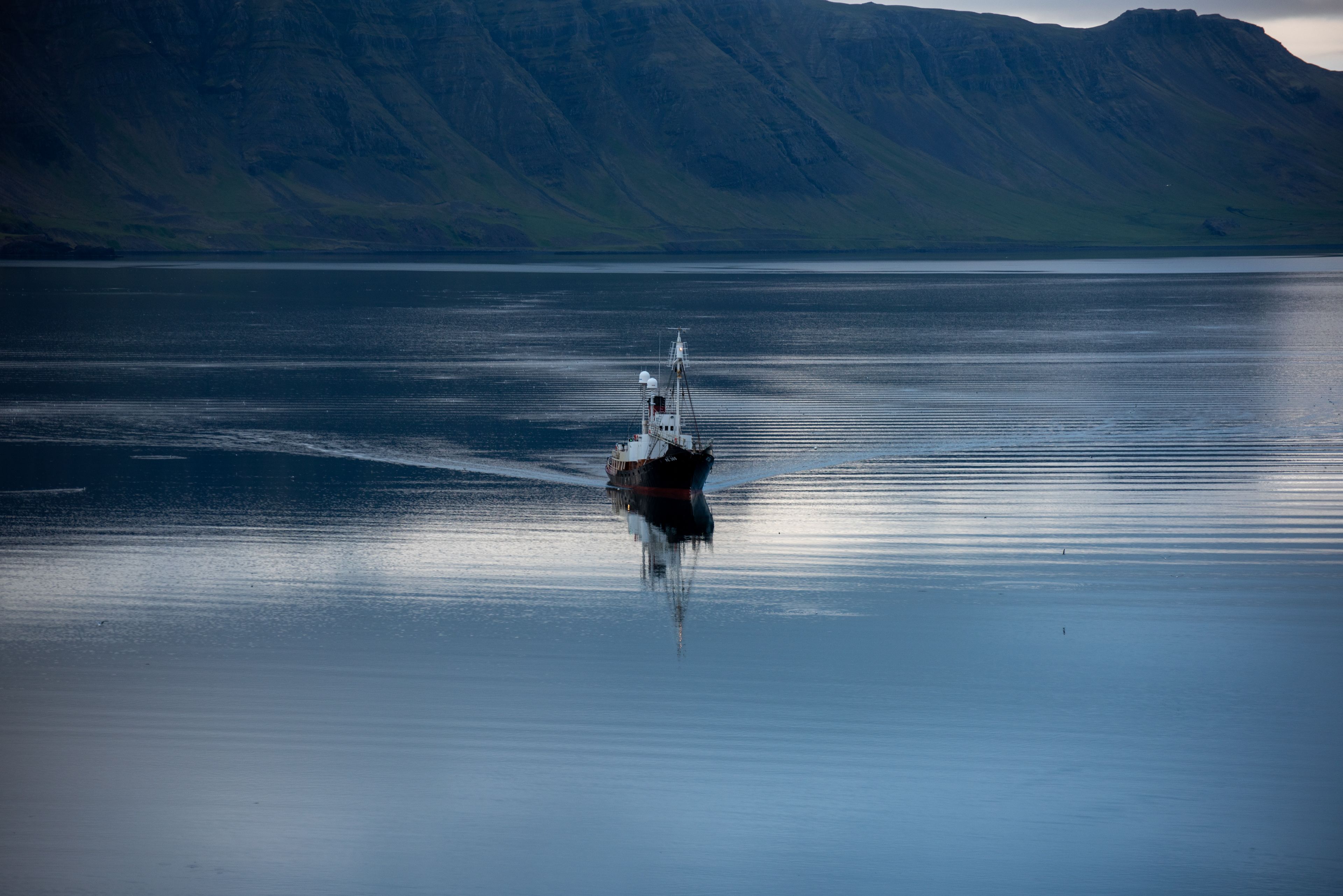
Exposing Hvalur hf
If you wake early enough to see the Whaling ships as they come in – in hvalfjörður, Iceland – you will see hulking vessels, still wearing their designs from 1948. Dragging along their sides are pairs of fin whales, often pregnant and often inflicted with multiple harpoons from their fin to stomach. These are the 'treasures' of the Icelandic company Hvalur hf (pronounced kva-lur) which is the last commercial whaler in Iceland.
Fin whales are monstrously large, like Lyngbakr in the Icelandic sagas. Residing as the second biggest mammal to ever exist - second only today to the even more giant blue whale. Fin whales can live for over 85 years naturally and roam the globe from Antarctica to Greenland and Canada. They are true ocean cruisers and very fast swimmers, living in the open seas often eluding divers and researchers. For thousands of years these colossi were not targeted by hunters because of this but as modernisation infected the world they became prey. Not even Arctic seafarers or inuit communities north of Canada hunted the fin whale.
Steam powered ships and explosive harpoons were the tools humanity used to decimate the fin whale. During the previous century over three quarters of a million fin whales were killed. This brought their population down to just 2%. Considering how important they are to the health of our oceans and our ecosystem this was disastrous. By the late 20th century the fin whale population was down to only a few thousand.
Hvalur 8 returning with two dead female fin whales in July 2022.
Hvalur 8 returning with two dead female fin whales in July 2022.
Kristján Loftsson is the CEO of the last commercial whaling operation in the North Atlantic - he's headed that company, Hvalur hf, since 1974. Iceland does not have an embedded history of whaling - Icelanders in the past have independently hunted whales for subsistence occasionally but it has never been a consistent part of the countries diet. It wasn't until 1948 (with the founding of Hvalur hf) that any commercial whaling in Iceland really took root.
Today - whaling mainly exists as extremely limited scientific expeditions and whale watching tourism. Minke whales are researched domestically and the studies have shown that less than 1% of Icelanders ever consume whale meat. Very few restaurants serve whale in reykjavik and none of them serve fin whale. Why then does Loftsson hunt the endangered species?
Why indeed... Hvalur hf (translating to literally "whale" in English) exports all the whale meat to Japan where, interestly also, whale meat is on the decline.
Luckily, Hvalur hf's licence that was granted by the Icelandic government will expire in 2023 and will hopefully never be renewed again. Loftsson's legacy is on the way out but he is determined to eek out the last remainding days of its existence by increasing his operations - over the season of 2022 he is expected to kill over 180 fin whales.
"Fin whaling is a disgrace brought upon Iceland by the cruel ambition of one man.. Kristján Loftsson."
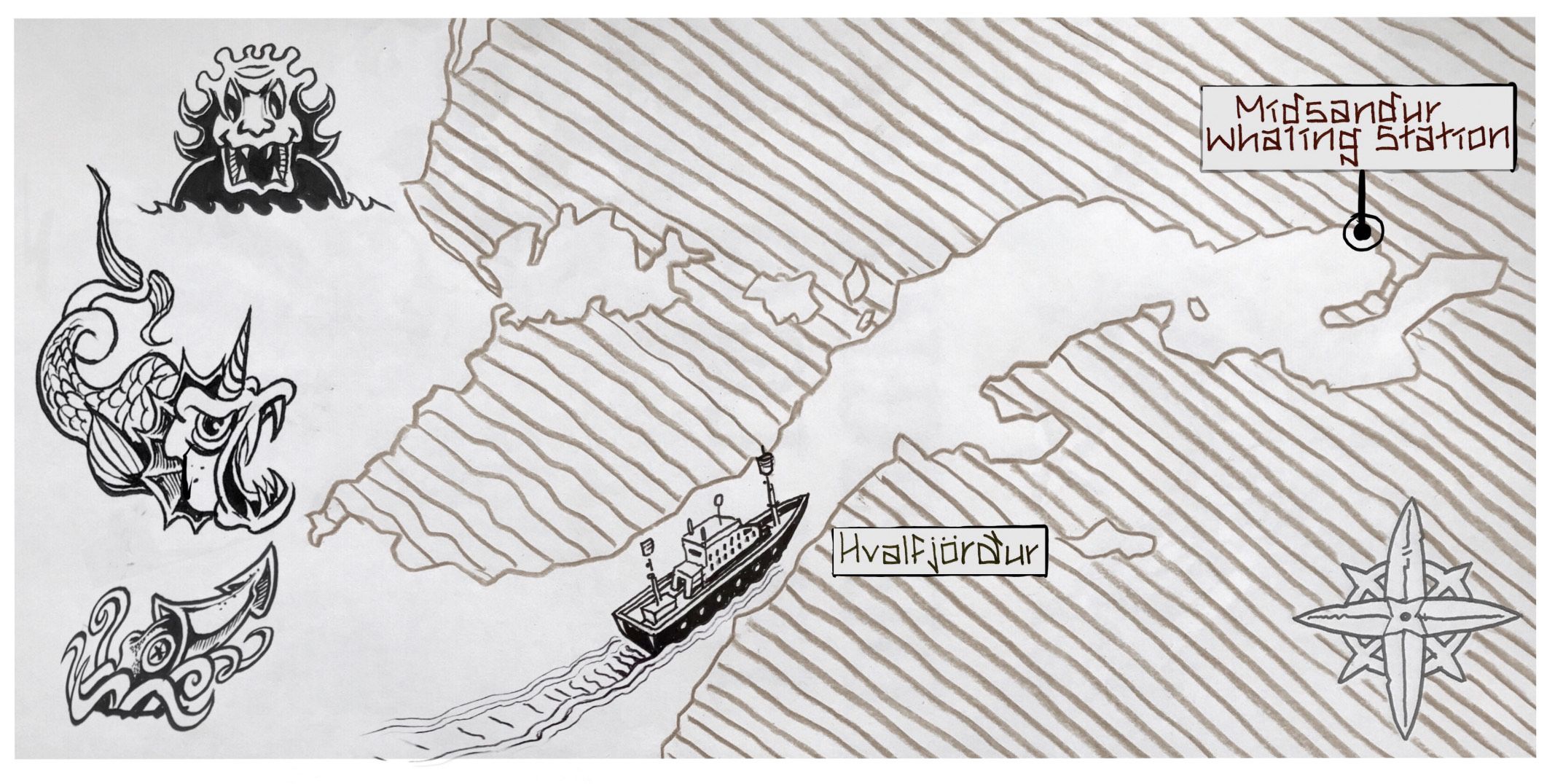
A mythological sketched map of the whale fjord, originally illustrated for this feature.
A mythological sketched map of the whale fjord, originally illustrated for this feature.
The heart of Hvalur's nefarious operation is the midsandur whaling station in the belly of the hvalfjörður, (Icelandic for Whale Fjord). Loftsson remains holed up in the station, like Kurtz in the heart of the Belgian Congo, or like some illegal settler in a layby desperately trying to lash himself to the nearest radiator. In 2018 his company was forced to cease operations by the Icelandic Food Administration due to poor hygiene conditions. This was revealed by the marine conservation society, Sea Shepherd at the time. Since the hygiene ruling in 2018, Hvalur has reduced its direct food processing at the facility.
Loftsson regularly visits there and oversees the processing. Like a vulture orbiting their dead prey. During this investigation I will detail more my personal experiences with the man but through whaling he was amassed a wealth reaching hundreds of millions of euros and has many stakes in fisheries and businesses in Iceland.
Loftsson's fleet is comprised of two archaic ships from the mid 1940s - Hvalur 8 & 9. They are advanced enough to stay out at sea for roughly 72 hours but roughly return every 30 hours with a pair of whales. They deposit them at the facility, re-fuel and resume their sleepless hunt. During the 1980s Loftsson's fleet boasted four ships until 1986 when Sea Shepherd scuppered and sank Hvalur 6 & 7 in the middle of Reykjavik harbour. A legacy that the marine conservation group are proud of - and rightly so. The action has single handedly saved potentially over 10,000 fin whales - over 10% of their total population today.
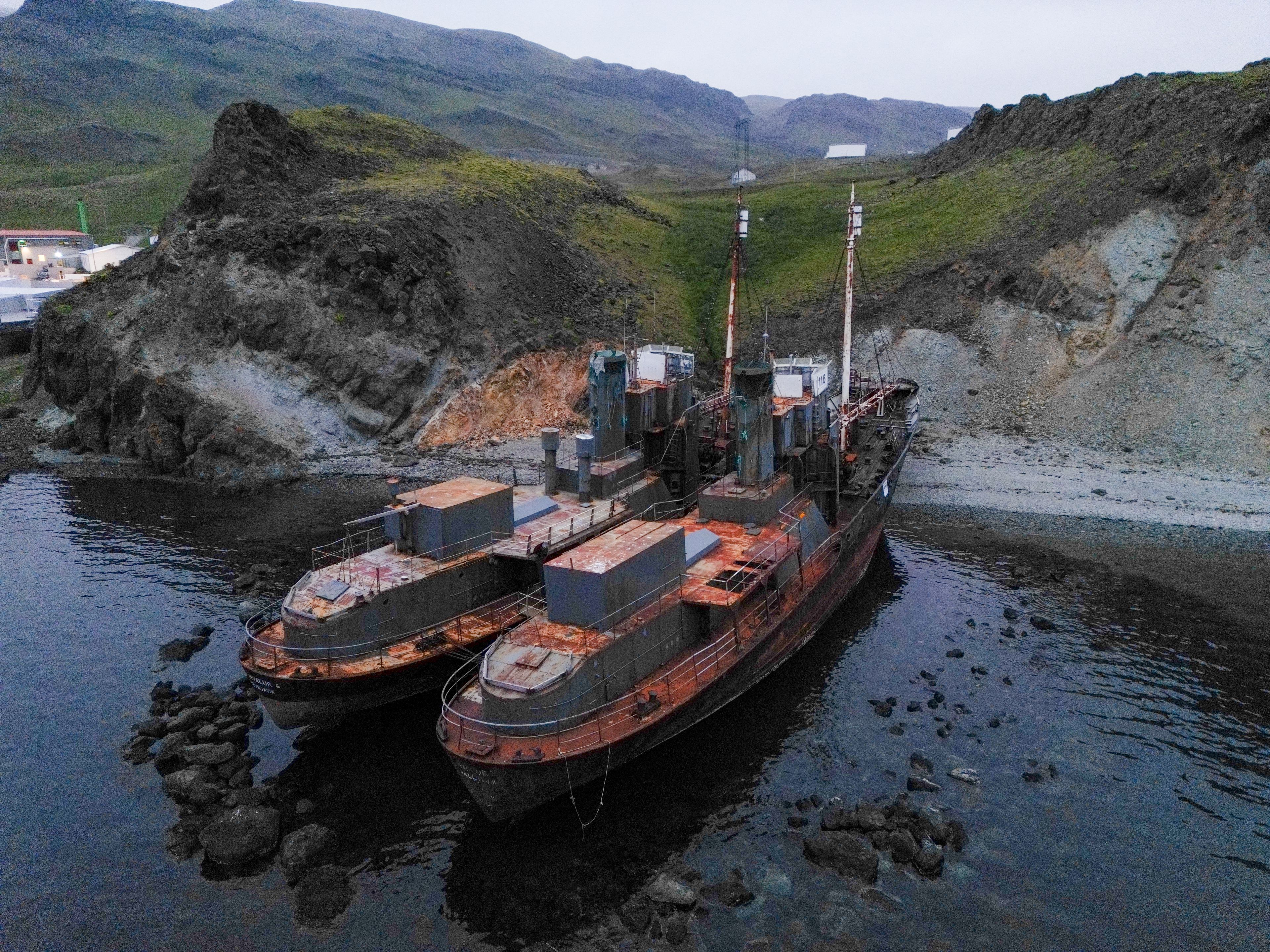
Hvalur 6 & 7, 36 years after being scuppered by Sea Shepherd.
Hvalur 6 & 7, 36 years after being scuppered by Sea Shepherd.
Today Hvalur 6 & 7 stand resigned and rusted next to the station. The pair were lifted from Reykjavik harbour and deposited next to the facility at midsandur. They have become a living reminder for conservationists that change happens with direct action and for Loftsson they have become a permanent reminder of Sea Shepherds active engagement. In past years Loftsson has used the remains of 6 & 7 to repair and maintain Hvalur 8 & 9. The designs dating back almost one hundred years means that they are quite easily repairable - parts can be machined and remade and there have been improvements made along the way. Notably to their speed - often outpacing other vessels.
I spent days watching the ships come in and out of the fjord, making sure to never miss a single rotation. The goal was to expose every cruel action Hvalur hf is taking and this meant countless hours spent through binoculars staring at the approaching horizon waiting for the familiar lights. After weeks of this I grew accustomed to the unmistakable pattern of the ships on the horizon. Iceland in mid summer never grows dark. It remains in a permanent stasis of sunlight where days bleed together. When a ship returns with one or two fin whales it takes five to six hours to process each whale - longer if they're a female and there is a fetus. I photographed and documented over 30 whales, inspecting each one.
Loftsson's 'professional' whalers have the skill of children. They kill whales using explosive tipped harpoons. They puncture the thick skin and detonate in the flesh. The textbook way of hunting the fin whale is a harpoon through the back of the neck into the brain. During my witnessing I saw often three or four harpoons in the whales tails and fins and bellies - none of which are killing blows. Each harpoon adds more than 30 minutes of excruciating pain for the whale. His professional hunters are so poor in-fact that they've been known to kill blue whale/fin whale hybrids as in 2018 one of these was delivered to the station. They are rare and very illegal to kill and sell but also this illuminates the shameful tactics that Hvalur employ. If there is any doubt at all that a whale isn't a fin whale then legally they shouldn't even attempt it. Their licence is exclusively for fin whales; which I will remind the reader again is an internationally endangered species...
I spoke to, Rob Read who is the Chief of Operations and director at Sea Shepherd UK about Hvalur hf and whaling within Iceland; "Kristjan Loftsson is risking the health of our oceans and our planet for pure financial gain. His workers are paid an extremely high wage to abandon their jobs to work for Hvalur every whaling season. Roughly one million Icelandic Króna per month."
The whaling season exists from roughly May to Late September and seems to attract a lot of workers. During my many many hours spent at the station I spoke to many native Icelanders who had worked there in years past. They were veterans of the station and many people came to observe Hvalur dissect whales. They came in fondness to remember their 'good ol' days' working there. One indigenous man told me whilst pointing at the dead whale, "Best meat in Reykjavik!" despite the fact no restaurant in the capital sells fin whale meat.
I reached out personally to Loftsson himself, to attempt to understand his side and hear his thoughts. Like any good journalist would do.
I saw his car parked outside the station's crew quarters, he drives a very fancy porsche, and decided to poke my nose in. I sent him an email earlier that day so I wasn't totally unknown to him. I stepped foot inside and began talking to Loftsson at which point he recognized me from the whaling station. He started hurling insults at me; I was a "Pest" and I should, "go to Hell". At which I promptly left before he got even more aggressive. All this to say to the reader - I tried. Loftsson views his work as his legacy and sees no problem in it at all and therefore could offer no comment to this exposure worthy of noting.
Drone footage of Hvalur hf returning with 2 female fin whales.
Drone footage of Hvalur hf returning with 2 female fin whales.
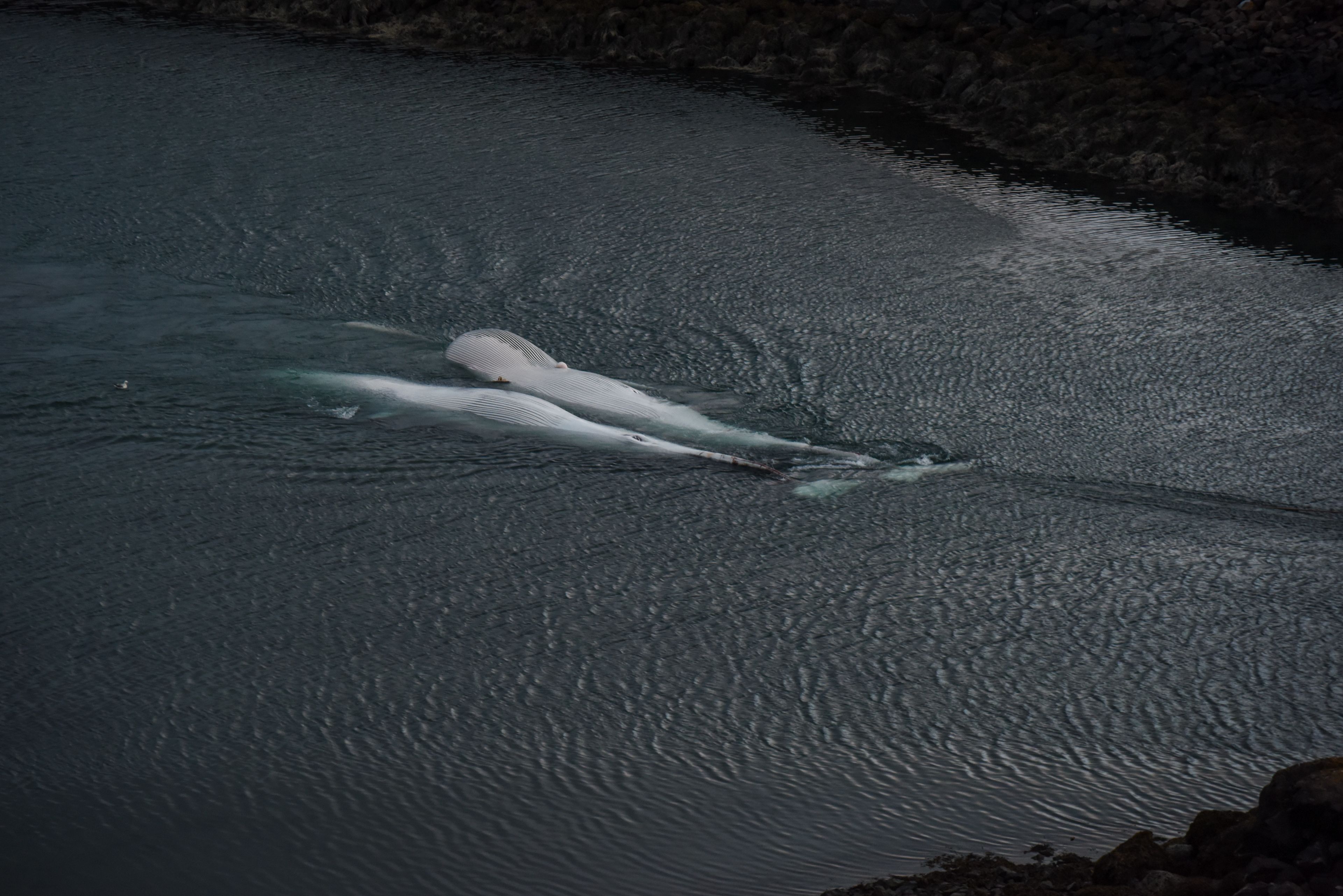


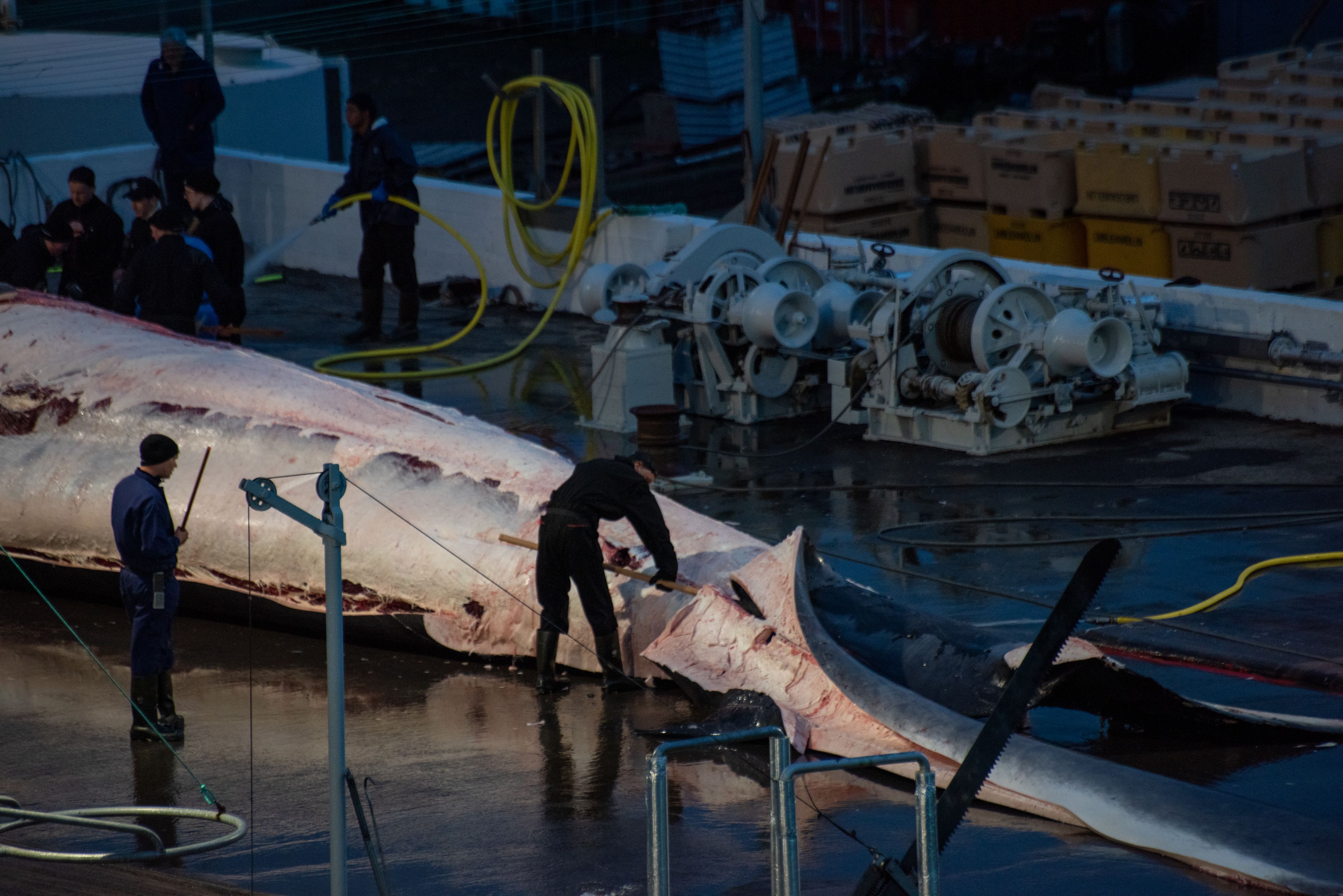
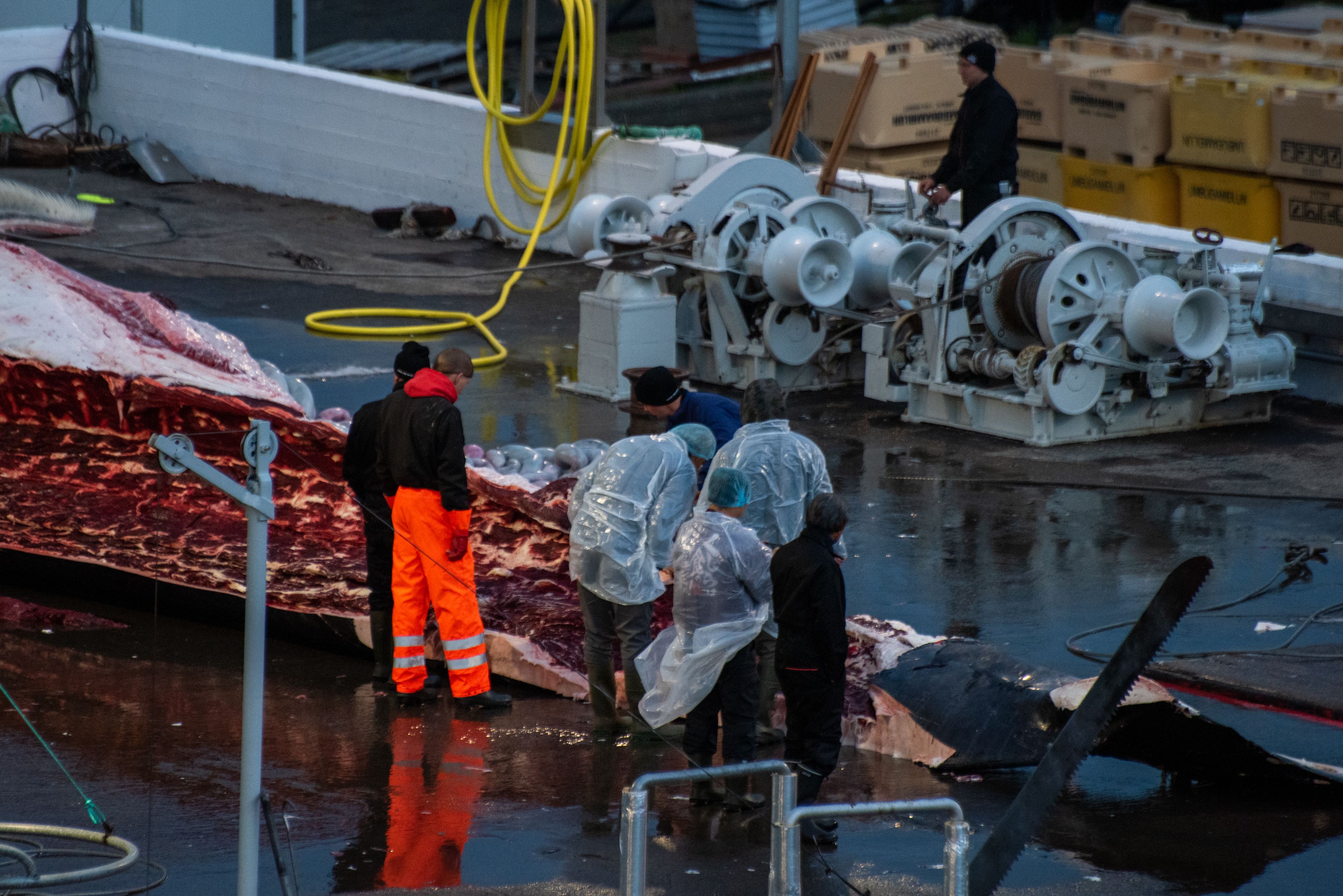
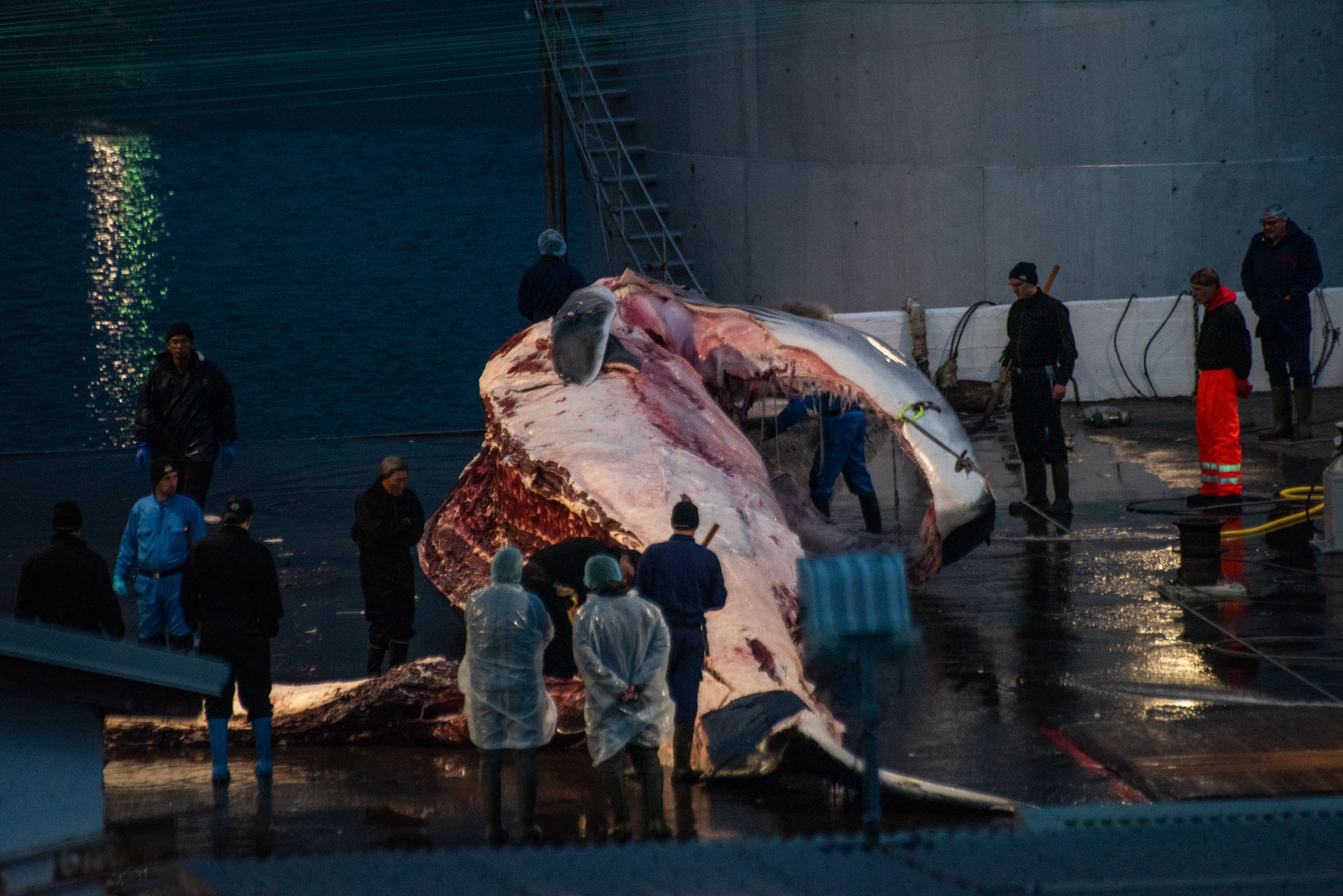

A pair of female fin whales being dragged from a ship onto the station.
A pair of female fin whales being dragged from a ship onto the station.

A dead female fin whale at the station awaiting dissection.
A dead female fin whale at the station awaiting dissection.

Heroes worthy of homer.
Heroes worthy of homer.

Crew of Hvalur hf are skinning a fin whale.
Crew of Hvalur hf are skinning a fin whale.

Japanese investors / customers are inspecting the meat.
Japanese investors / customers are inspecting the meat.

The jaw being winched back whilst investors observe.
The jaw being winched back whilst investors observe.
Video of Hvalur butchering whales.
Video of Hvalur butchering whales.
Something that the videos and photos do not translate is the smell. The decaying flesh of whale as they are dissected and incinerated. The pungent odour remaining days after the last piece is removed, the smell lingers in the air like a ghost of christmas past.
During the later days of my investigation I witnessed them testing their harpoons on the dead carcasses. Sea Shepherd had been following their ships out of Icelandic waters even as far as the arctic circle north of Greenland. I suspect they feared that Sea Shepherd would argue they were inhumanely slaughtering the whales using evil harpoon tactics. Hvalur was therefore testing their weapons to propose a humane argument. No member of Hvalur would agree to comment but that is my strong suspicion. Following that logical idea would be the logical conclusion that any testing they did wouldn't change the result. Their harpooning tactics are evil. They are explosive tipped so pierce the skin then detonate internally. Often these harpoons puncture the tail and fins and belly which do not kill the whale. They only ensure prolonged suffering, often hours of excruciating pain.
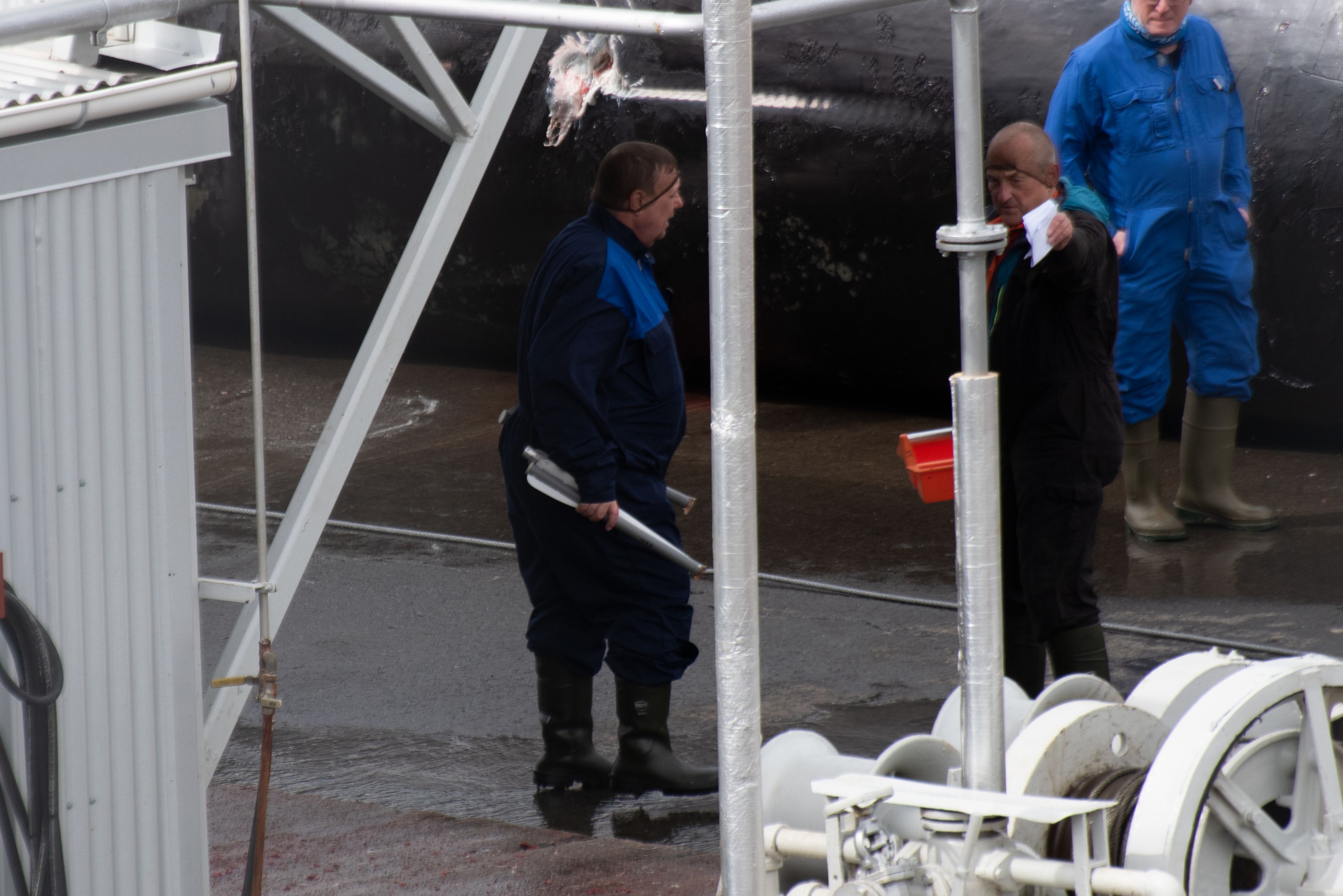
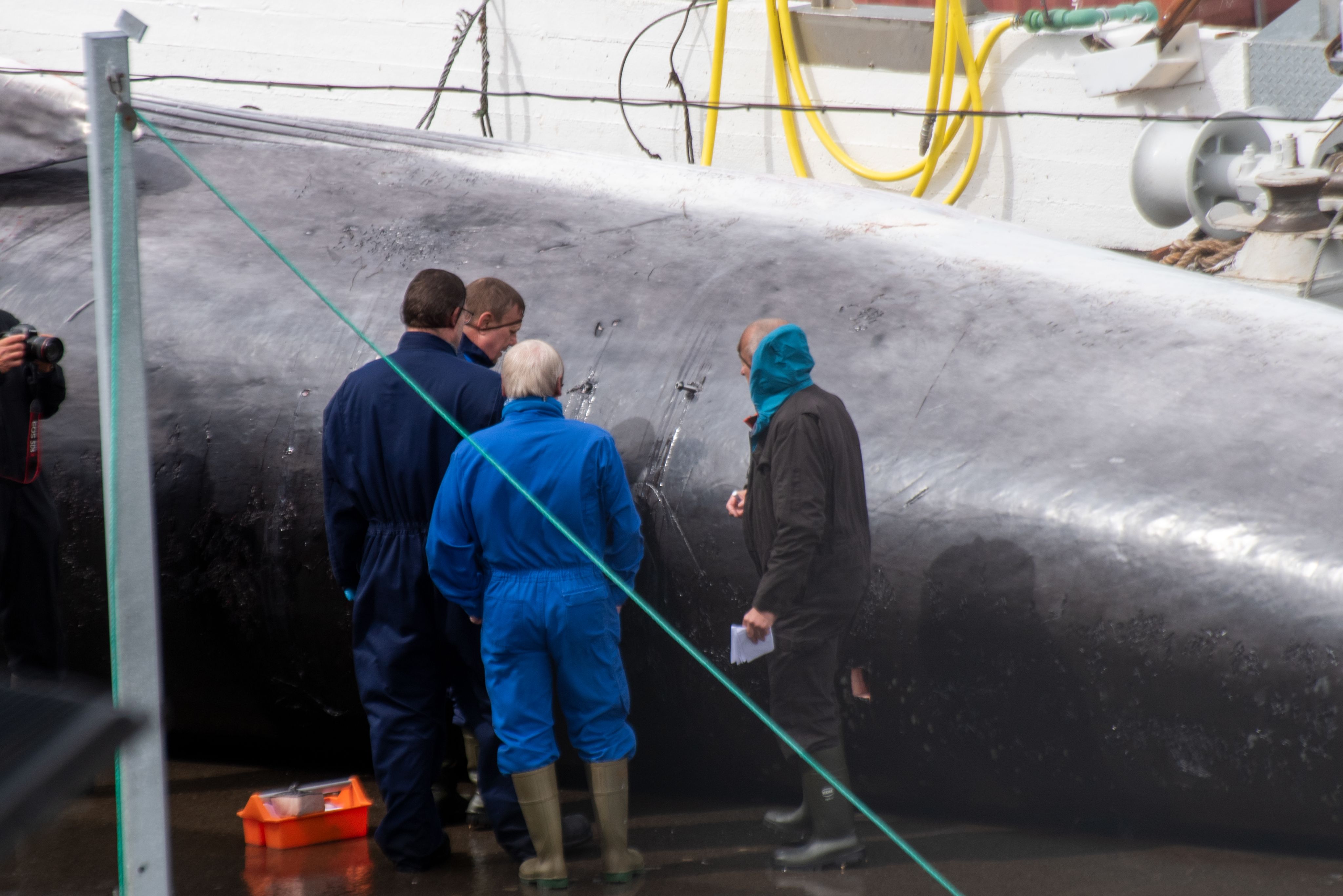

Crew preparing suspected harpoon testing.
Crew preparing suspected harpoon testing.

Crew inspecting suspected harpoon damage. Look closely and you'll see multiple bolts in the skin.
Crew inspecting suspected harpoon damage. Look closely and you'll see multiple bolts in the skin.
After seeing so much monstrous death I begin to become desensitised to the images. It becomes difficult to remember that not 24 hours earlier these huge goliaths were free and happy roaming the world. Great Apes and Cetaceans are the two types of species, uniquely, that have unusually large brains for their mass. They are extremely intelligent. Sperm whales in the past during the industrial revolution famously learned to escape whalers in the 1800s.
I'm often unsure how I feel about the individuals who commit these acts. Do we blame the employees of Hvalur for the companies acts? They could of course choose other employment - Iceland is certainly not a poor country. Do we blame consumers for almost forcing the market conditions to allow whaling possible... does the blame land at solely Loftsson's feet. These are questions that are important to ponder and I hope that this short feature has left room for thought with the reader.
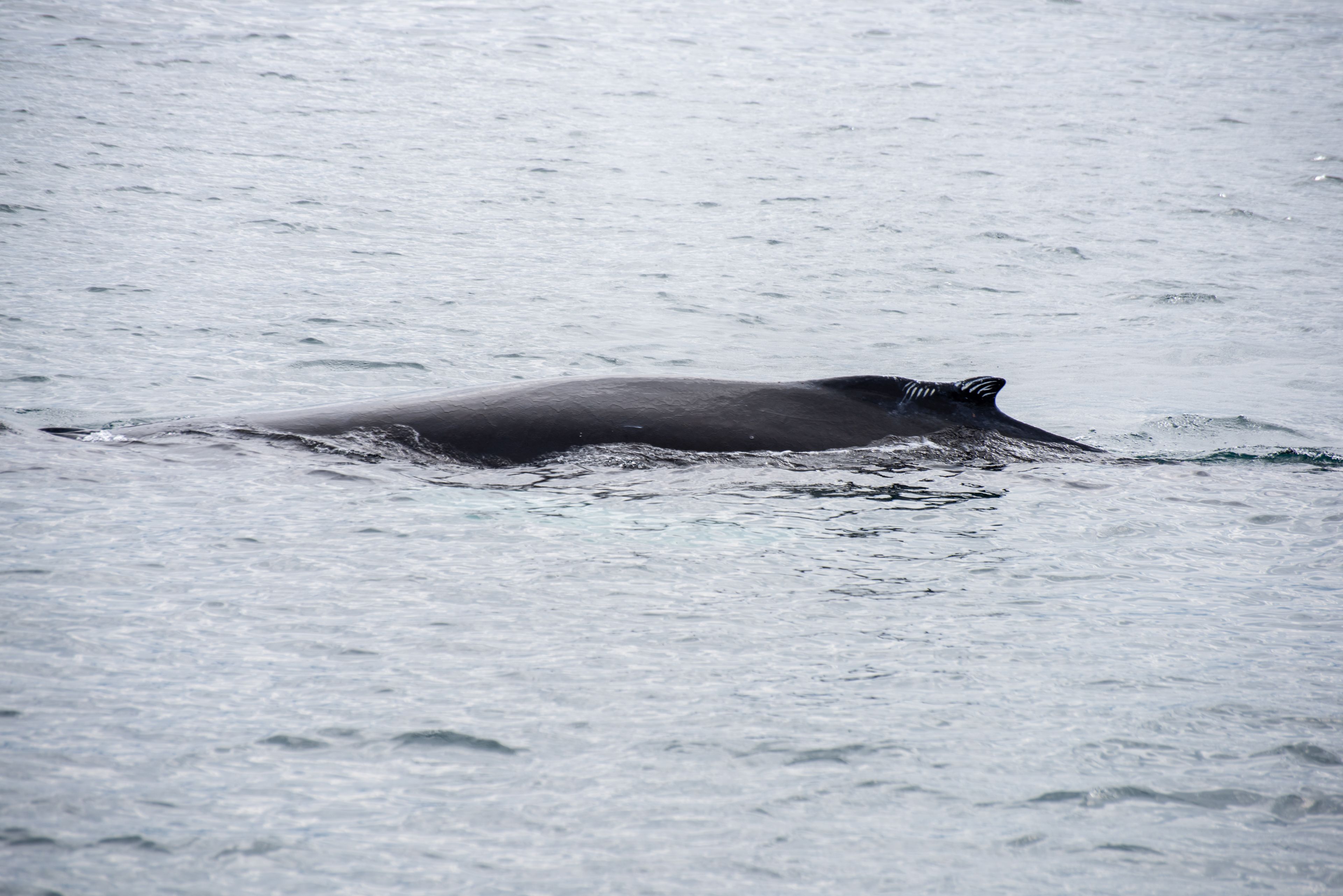
A humpback whale in the seas outside Reykjavik.
A humpback whale in the seas outside Reykjavik.
Iceland started commercial whaling a lot later than other countries. After two attempts that were unsuccessful at in the early 1900s it wasn't until Hvalur in 1948 that it became embedded, before this only small operations existed. During the period of 1941 to 1986 (year of the IWC), 4,000 minke whales were caught. In comparison, they caught 8,887 fin whales. Iceland stopped whaling in 1989 however they withdrew from the IWC in 2002 and resumed scientific whaling in 2003. They resumed commercial whaling in 2007. These statistics were kindly given to me by Elding Whale Watching, which are a commercial whale watching tour service out of Reykjavik. Whale watching has become a huge pull for tourism and far far exceeds any profit from killing them.
Whale watching is an ethical way to responsibly enjoy whales. It is a tool for education and for conservation. The larger the whale watching industry, the more demand for protected conservation areas. This offers a very real and ethical alternative and one that actually generates more money. There are of course concerns about whale watching. For example irresponsible pursuing and noise pollution (which is worthy of a feature series on its own).
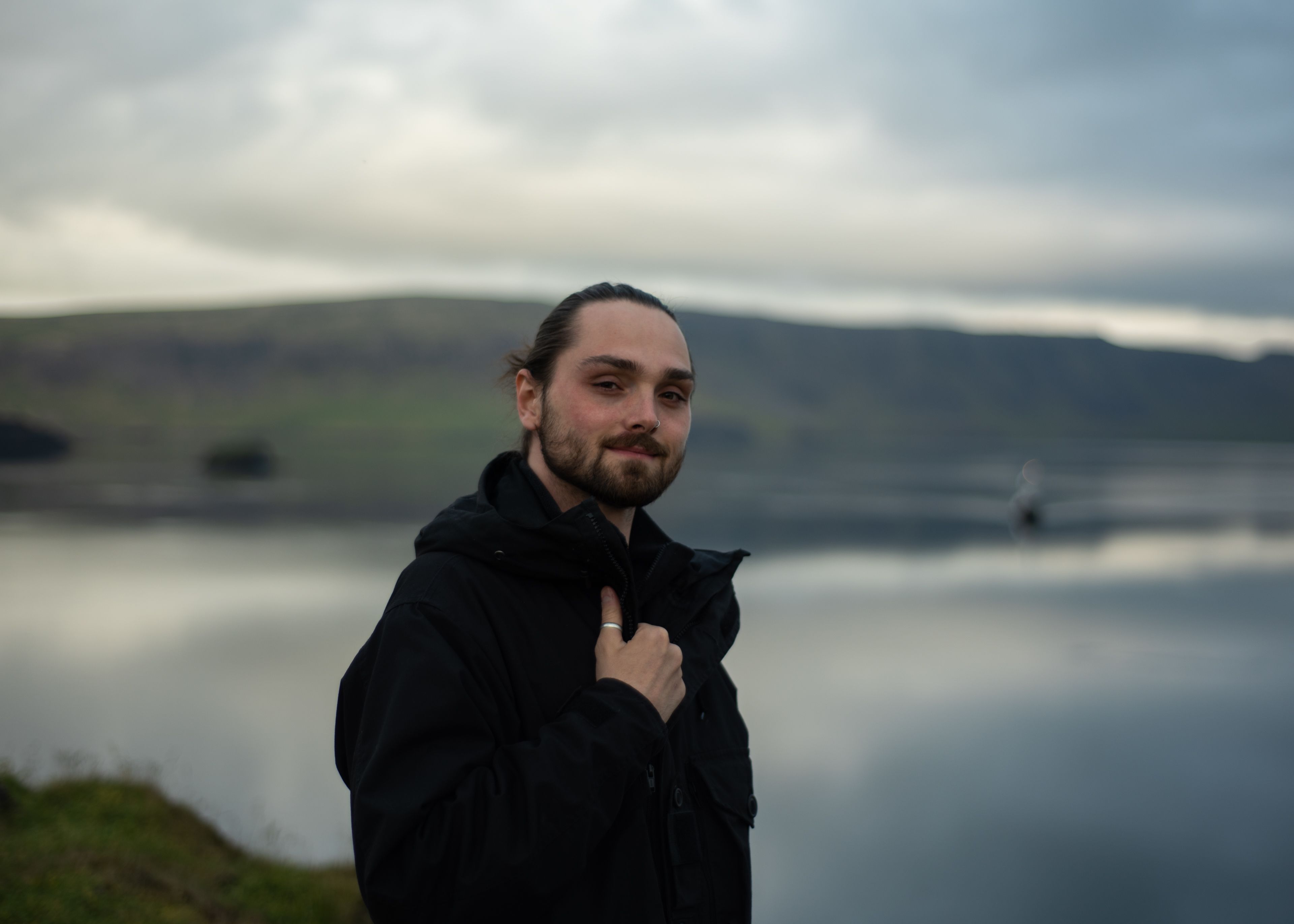
Ky standing outside Midsandur whaling station. A Hvalur ship is returning [right].
Ky standing outside Midsandur whaling station. A Hvalur ship is returning [right].
The purpose of this feature has been to expose and illuminate the actions of Hvalur hf and the man behind it, Kristán Loftsson. As a global species, mankind is more conscious than ever of looking after this garden of a planet. We're seeing increased threats of climate change and deforestation which impact people's lives more every year. Our oceans are vital in regulating our environment and cetaceans are crucial in their health.
Iceland is a mystical country cloaked in mythology and wonder. It is to Icelands' own shame this visage is broken.

